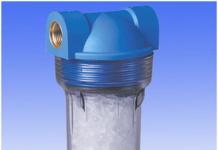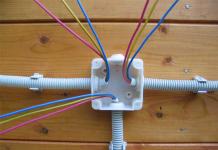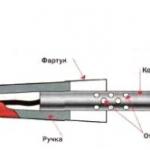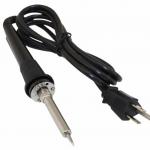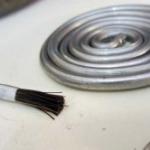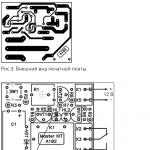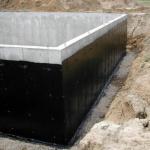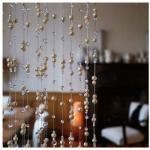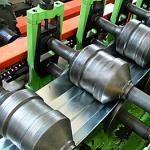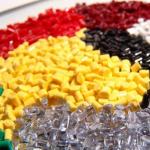Soldering is a method of creating a permanent connection by introducing into the contact zone a molten material with a melting temperature lower than that of the materials of the parts to be joined. You can learn how to properly solder with a soldering iron by mastering the technology in practice.
Purpose of the device
The electric soldering iron is produced with a supply voltage from 12 to 220V. It is difficult to manufacture a low-power structure for high voltage, since this requires many layers of thin wire, which leads to an increase in dimensions. In addition, it is chosen based on the conditions of work safety.
It is convenient to choose the power of the soldering iron using a simple table:

Optimum tip temperature is maintained manually or automatically. For this, thyristor regulators are used.
To increase the service life, the end of the soldering iron can be forged. In this case, copper will dissolve less in the solder. Before using the soldering iron, the tip is filed into a certain shape. The most common are angular and cut. A knife-shaped end is attached in order to simultaneously solder several contacts of a microcircuit or connector pins.

Tools
Before properly soldering with a soldering iron, the work area should be equipped with the necessary tools:
- Stand. The heated device is placed on a stand. It also serves as a place for flux and is a platform for working with wires. A “crocodile” is additionally attached to it with a piece of foam rubber for cleaning the sting.
- Tripod. It includes clips (“crocodiles”) that can be moved in height and rotated, a rosin tray, a soldering iron holder.
- Set of tools. It is needed to support parts, give wires the desired shape, and clean solder surfaces. These tools include tweezers, pliers, wire cutters, round nose pliers, files, a knife, and sandpaper.
Soldering secrets

How to use a soldering iron?
Foreign matter is removed from the surfaces of parts by grinding with sandpaper and degreasing with acetone or gasoline.
The sting is cleaned of oxides and burning with a file, bar or sandpaper.
The soldering iron is heated, its end is covered with rosin, and then tinned. To do this, the solder on the tip is rubbed with a wooden block. The entire work surface should acquire a characteristic silver color.
Solder heats up. Its small part in the form of a drop is applied to the junction and leveled. If necessary, it is added to the required amount until it closes the contact point. The connection area is warming up. How to solder wires? The contact of the tip with the conductor should be as large as possible, and not the tip, as inexperienced installers do. In this case, the rosin must still remain on the drop of solder so that its oxidation does not begin. The soldering process is carried out in one step. If you retract and re-press the tip against the part several times, the solder will turn gray due to oxidation, since the rosin evaporates earlier. During the cooling process, the parts must be motionless. When the wires are displaced, when the solder has not yet solidified, microcracks form in it, which worsen the strength of the connection and create additional electrical resistance.
The remains of rosin are removed with a brush moistened with alcohol.
Soldering wires
We will figure out how to properly solder the wires with a soldering iron. First of all, their ends intended for connection are released from insulation. It is important to warm up the connected wires with high quality. To do this, the dimensions of the sting must correspond to the dimensions of the parts. If the soldering iron is too large, then neighboring elements will be damaged during operation. With its small size, soldering will be unreliable, since the parts are difficult to warm up.
Wire preparation consists in removing insulation from its end. It is removed with a knife or wire cutters. The stranded wire should be twisted so that individual parts do not stick out, and tinned. To do this, it is lowered into a bath with rosin, a drop of solder is taken with a soldering iron and carried out several times over the copper wires. During the tinning process, the wire must be heated and rotated so that the coating is on all sides. To prepare for further work, the tinned end is dipped in molten rosin and thus “varnished”. Its excess can then be easily removed by hand.
Solder is a weak alloy and breaks under small loads. The wires to be connected are pre-stripped and twisted. To do this, they must have a common axis. Their centers should be combined, after which one wire is twisted along the length of the other. A similar operation is done with the second end. A molten rosin is applied to the junction, and then solder. The twist should be warmed up for 2-3 seconds.

If there is not enough solder, it must be added so that the coating is uniform and shiny. Many do not understand why the connection does not warm up even with a powerful device. How should soldering be done with a soldering iron in this case? The fact is that heat spreads from the bottom up. Therefore, the twist must be heated from below. When overheated, the solder spreads, and when there is not enough heat, the coating is loose.
Single-core wires are cleaned to a shine and dipped in rosin. Then they are connected, heated for 3-5 seconds. and apply solder. A heat shrink tube of a larger diameter is put on the bare wire, which decreases from elevated temperature, after which reliable insulation is formed. If the spike cools quickly, a lighter is used to heat it up. Having mastered how to solder wires correctly, you can proceed to more complex operations.
It is unacceptable to twist together copper and aluminum wires due to heat generation in the contact resistance. Their fixation is carried out through an intermediate element, which can be a bolted connection with separation by washers, a terminal clamp, a layer of another metal. Tin-based aluminum solder is also suitable for copper wire and can be a reliable intermediate layer for them.
Soldering radio components
Soldering with a radioelement is carried out by twisting or overlapping, using a heat sink, for example, with tweezers. Heating of many parts of electrical circuits should not exceed 70 ºС for a duration of more than 3 seconds.
On the printed circuit board, the mounting location along the perimeter of the hole is covered with a layer of solder. Then the tinned and rosin-coated end of the conductor is inserted into it. It is heated and moistened with an added drop of solder. The tip should touch the pin and track of the board at the same time. Excess solder is easily removed with a copper braid. The work is done with high quality when all soldering points are similar to each other. The conclusions of the radio elements are bent and inserted into the holes of the board. The ends on the reverse side are slightly bent so that the part does not fall out.
The soldering iron cannot be kept dry for a long time in a heated state. It is covered with a layer of oxides, and the sting will again have to be cleaned and tinned. At the end there should always be a layer of molten rosin, and in long intervals between work, the soldering iron should be turned off. Also, old solder is periodically removed from it with a sponge.
Elements of boards of various equipment can fail under the influence of static electricity. To prevent its occurrence, the body of the soldering iron should be grounded.
Working with microcircuits
Consider how to solder microcircuits correctly. The process has some peculiarities. Microcircuits cannot withstand overheating. There should be no excess solder at the joints. To do this, use a soldering iron for microcircuits with temperature control.
Simultaneous heating of the contacts is carried out using a hair dryer with nozzles. The area on the board needs to be cleaned. Acetone or universal lacquer thinner is suitable for this. Then the hair dryer is turned on, and its temperature is set at 330-370 ºС. At the minimum blowing speed, the chip heats up and is immediately removed with tweezers after the contacts are melted. Then the soldering zone is lubricated with flux, and a new microcircuit is installed in place of the faulty one. When heated with a hairdryer, it sags a little from the melting of the contacts, which is a signal of the end of the operation. The soldering area is wiped with acetone to remove flux residues. Sufficiently powerful contacts can be additionally heated with a soldering iron.
When the simple one is mastered, it is possible to switch to complex compounds, for example, dissimilar metals using gas, furnace or impulse heating.

Aluminum soldering
Difficulties in soldering aluminum are associated with its low melting point (660 ºС) and strong oxide film. The parts are heated in a furnace or gas flame burner. Their preparation consists in removing fats with a solvent and in mechanical cleaning with sandpaper, an abrasive wheel or a stainless steel brush. In this case, the oxide film is formed again, but its thickness is much less than the previous one. Then a flux is applied to the junction and it is heated to the melting temperature of the solder. The electrode rod is touched to the junction until it begins to melt.

Solder for soldering aluminum at a temperature of 150-400 ºС can be based on zinc, tin, cadmium (fusible). It poorly resists corrosion and requires additional coatings. Refractory solders, such as silumin (590-600 ºС), 34A (530-550 ºС) and others, are more reliable and are used more often. Aluminum alloys have a lower melting point. They are soldered with furnace heating, which is more precisely regulated.
Conclusion
How to solder wires and microcircuits with a soldering iron? The answer to this question implies, first of all, careful preparation of the tool and parts. In the process of creating a permanent connection, the layer of molten solder must always be protected by flux. For each operation, a soldering iron of the appropriate power and shape of the working surface of the tip is selected. With the correct connection of the parts and maintaining the temperature regime, the soldering is reliable and lasts a long time.
Almost every man, whether he is an ardent fan of digging into radio equipment and electrical appliances, or a simple owner, faced with a situation in which the process of joining metals, wires is required, sooner or later will be forced to use a soldering iron, in which case you can try it yourself cope with the task by learning to solder.
Devices and tools necessary for the soldering process
In everyday life, when it is necessary to fix something elementary, special experience and expensive units and tools for soldering are not required. The main instruments are the following:
- soldering iron. The main criteria for choosing it are the size, which must correspond to what you are going to solder, otherwise there is a risk of damage to adjacent circuit elements or poor-quality soldering of wires and power (it is advisable to purchase a pair of soldering irons, one for 25 watts for soldering microcircuits, the second for 40- 60 watts for soldering wider parts).
- Stand for soldering iron. When working with a soldering iron for a long time, it often has to be disconnected from the mains in order to avoid overheating, then wait again until it heats up. Due to the fact that the soldering iron heats up to 300 degrees, you simply cannot do without a stand for it.
- Rosin and solder. Rosin is an amorphous substance obtained from the resin of coniferous trees, which is very brittle under mechanical shock. What is rosin for? When soldering, it is used to degrease the surface and remove oxide films. Solder is an alloy of two metals - lead and tin for soldering.
 Preparation of tools and materials for soldering
Preparation of tools and materials for soldering
Soldering is the process of connecting parts by introducing molten metal at a lower temperature into their contact zone. Before you start soldering, you must carefully prepare for work:

Recommendations for competent work with a soldering iron using rosin
 Rosin is easily soluble in organic compounds such as alcohol, acetone and others. When heated to 150 degrees, it is able to split such chemical elements as tin, lead, copper.
Rosin is easily soluble in organic compounds such as alcohol, acetone and others. When heated to 150 degrees, it is able to split such chemical elements as tin, lead, copper.
Rosin is used in radio and electrical repair work as an antioxidant component for soldering. Her competent application will significantly reduce the spreading and surface tension of the solder, destroy the oxide film and prevent the formation of a new one.
Before you start soldering the necessary elements, you need to clean and then tin the contacts. To do this, lay out a piece of solid rosin on a part of the surface that will be soldered and press it with a soldering iron heated to the required temperature.
If the task is to solder the microcircuit, then you need to dip the tip of the soldering iron in rosin and coat the wire twist with it, which will ensure the free flow of tin to the place of soldering.
 If the solder was not used in sufficient quantity and in some places part of the twist or wire is visible, it is necessary to repeat the previous step.
If the solder was not used in sufficient quantity and in some places part of the twist or wire is visible, it is necessary to repeat the previous step.
Further, placing the solder at the place of soldering, it is recommended to run a soldering iron tip over it, as a result of which it will melt. If the material is processed poorly, then it is possible that the solder will not stick to the surface.
Of course, it is possible to solder without the use of rosin, but the quality of the soldering place and the aesthetic appearance of the product will be lost. In the absence of rosin in everyday life, soldering acid, an electrolyte from an old battery, coniferous resin dissolved in acetic acid, or acetylsalicylic acid may be useful as a replacement. And yet the best solution is not only the use of rosin when soldering, but also using it with a margin for a more reliable bond. Until the composition hardens, do not move the soldering parts.
With effective tinning, soldering will occur almost instantly, it remains only to wait until the solder has completely cooled down. On many Internet sites you can find videos with simple lessons on how to use a soldering iron, learn how to solder. If you follow the detailed instructions, then there is no particular difficulty in the process itself, to achieve a positive result, you just need to do everything clearly and successively .
When thinking about how to properly use a soldering iron using rosin, do not forget about the need for careful preparation of tools and parts for the soldering process. When creating a permanent connection, the solder layer must be protected with rosin. For each individual soldering case, a soldering iron of the appropriate size and power may be suitable. With the correct attachment of parts, soldering becomes reliable and durable.
Soldering with a soldering iron is one of the most common and simple soldering methods, but it has two significant limitations. Firstly, a soldering iron can only be soldered with low-melting (soft) solders, and secondly, they cannot (or, in any case, it is difficult) to solder massive parts with a large heat sink - due to the impossibility of heating them to the melting temperature of the solder. The last limitation is overcome by heating the soldered part with an external heat source - a gas burner, an electric or gas stove, or in some other way - but this complicates the soldering process.
Before you solder with a soldering iron, you need to get everything you need. The main tools and materials without which soldering is impossible include the soldering iron itself, solder and flux.
Soldering irons
Depending on the method of heating, soldering irons are "normal" - electric (with a spiral or ceramic heater), gas (with a gas burner), hot air (heat is transferred by air flow), induction. Massive hammer soldering irons can be heated not only with electricity, but also in the old fashioned way - with an open flame.
How to use such a soldering iron, you can learn from the descriptions of the technology of tin work, it was there that they were used most often. Nowadays, electric soldering irons are usually used due to their availability and ease of use. But the first soldering irons were heated by an open flame.

The main parameter by which a soldering iron is selected is its power, which determines the amount of heat flux transmitted to the soldered parts. For soldering electronic components, devices with a power of up to 40 W are used. Thin-walled parts (with a wall thickness of up to 1 mm) require a power of 80-100 watts.


For parts with a wall thickness of 2 mm or more, you will need soldering irons with a power higher than 100 watts. These are, in particular, hammer electric soldering irons that consume up to 250 W and more. The most energy-intensive soldering irons include, for example, the Ersa Hammer 550 hammer soldering iron with a power of 550 W. It is capable of heating up to a temperature of 600°C and is designed for soldering particularly massive parts - radiators, machine parts. But he has an inadequate price.

In addition to the massiveness of the part, the thermal conductivity of the soldered metal also affects the required power of the soldering iron. With its increase, the power of the device and the temperature of its heating must be increased. When soldering copper parts with a soldering iron, it must be heated more strongly than when soldering a part of the same mass, but made of steel. By the way, when working with copper products, a situation may arise when, due to the high thermal conductivity of the metal, during soldering, desoldering of previously completed places will occur.
Solders
When soldering with electric soldering irons, low-temperature tin-lead (POS-30, POS-40, POS-61), tin-silver (PSr-2, PSr-2.5) or other solders and pure tin are used. The disadvantages of solders containing lead include the harmfulness of the latter, the advantages are the better quality of soldering than lead-free solders. Pure tin is used for soldering food utensils.
Fluxes
It is generally accepted that tin, silver, gold, copper, brass, bronze, lead, nickel silver are well soldered. Satisfactory - carbon and low alloy steels, nickel, zinc. Poor - aluminum, high-alloy and stainless steels, aluminum bronze, cast iron, chromium, titanium, magnesium. However, without disputing these data, it can be argued that there is no poorly soldered metal, there is poor preparation of the part, incorrectly selected flux and incorrect temperature conditions.Choosing the right flux for soldering means solving the main soldering problem. It is the quality of the flux that determines, first of all, the solderability of a particular metal, the ease or difficulty of the soldering process itself, and the strength of the joint. The flux must correspond to the material of the soldered products - its ability to destroy its oxide film.
Acidic (active) fluxes, such as "Soldering Acid" based on zinc chloride, cannot be used when soldering electronic components, as they conduct electricity well and cause corrosion, however, due to their aggressiveness, they prepare the surface very well and are therefore indispensable when soldering metal structures, and the more chemically resistant the metal, the more active the flux should be. Residues of active fluxes must be carefully removed after soldering is completed.
Effective fluxes for soldering steel are an aqueous solution of zinc chloride, soldering acids based on it, flux LTI-120. You can use other, stronger fluxes, which abound on the market.

The main difference between soldering stainless steels and soldering carbon and low-alloy steels is the need to use more active fluxes, which are required to destroy the chemically resistant oxides that coat stainless steels. As for cast iron, it must be soldered with high-temperature soldering, and, therefore, an electric soldering iron is not suitable for this purpose.
For stainless steel, phosphoric acid is used. Well cope with a chemically resistant oxide film and specialized fluxes, such as, for example, F-38.

For galvanized iron, you can use a composition containing rosin, ethyl alcohol, zinc chloride and ammonium chloride (flux LK-2).
Auxiliary materials and devices
You can do without some devices and materials used for soldering, but their presence makes the work much more convenient and comfortable.Soldering iron stand serves to ensure that the heated soldering iron does not touch the table or other objects. If it does not come with a soldering iron, it is purchased separately or made independently. The simplest stand can be made from a thin sheet of tin by cutting grooves in it for laying the tool.

Wet rayon or foam sponge, placed in a nest to prevent falling out, it is much more convenient to clean the tip of the soldering iron than with a regular cloth. Brass shavings can also serve for the same purposes.

You can remove excess solder from the surface of the parts using special suction or braids. The first in appearance and design resembles a syringe equipped with a spring. Before use, it must be cocked by drowning the stem head. Bringing the spout to the molten solder, the spring is lowered by pressing the release button. As a result, excess solder is drawn into the removable head.

It is a braid of fluxed thin copper wires. By attaching its end to the solder and pressing it on top with a soldering iron, thanks to capillary forces, you can collect all the excess solder in it like a blotter. The tip of the braid, saturated with solder, is simply cut off.


A very useful device is called third hand(Third-Hand Tool). When working with a soldering iron, sometimes there are catastrophically "not enough hands" - one is busy with the soldering iron itself, the other with solder, but you still need to keep the parts to be soldered in a certain position. The "third hand" is convenient in that its clamps can be easily installed in any position relative to each other.

Solder holder "Third hand"
The soldered parts are heated to a high temperature, touching them can cause burns. Therefore, it is desirable to have various clamping devices that allow you to manipulate heated parts - pliers, tweezers, clamps.
Preparing the soldering iron for work
The first time you turn on the soldering iron, it may start to smoke. There is nothing wrong with this, the oils used to preserve the soldering iron just burn out. You just need to ventilate the room.Before using the soldering iron, you need to prepare its tip. Preparation depends on its original form. If the tip is bare copper, the tip can be forged into a screwdriver shape, which will compact the copper and make it more resistant to wear. You can simply sharpen it with sandpaper or a file, giving it the necessary shape - in the form of an acute or truncated cone with a different angle, a tetrahedral pyramid, an angular bevel on one side. Nickel metal coatings are used to protect copper from oxidation. If the soldering iron has such a coating, then it cannot be forged and sharpened in order to avoid damage to the coating layer.
There is a unified range of tip shapes, but you can, of course, use any shape suitable for a particular job.

When soldering massive parts, the area of contact between the soldering iron and the part should be as large as possible to ensure better heat transfer. In this case, the angular sharpening of a round rod is considered the best (2 in the photo above). If you intend to solder small parts, then a sharp cone (4), knife or other forms with small angles will do.
The instructions for working with a soldering iron with an uncoated copper tip contain one mandatory requirement - tinning the "sting" of a new soldering iron in order to protect it from oxidation and wear. And this should be done at the first heating, without delay. Otherwise, the "sting" will be covered with a thin layer of scale, and the solder will not want to stick to it. This can be done in different ways. Warm up the soldering iron to operating temperature, touch the "sting" to the rosin, melt the solder on it and grind the latter on a piece of wood. Or wipe the heated tip with a cloth moistened with a solution of zinc chloride, melt solder on it and rub it over the tip with a piece of ammonia or rock salt. The main thing is that as a result of these operations, the working part of the tip is completely covered with a thin layer of solder.
The need to tin the tip is caused by the fact that the flux gradually corrodes, and the solder dissolves the tip. Due to the loss of shape, it is necessary to sharpen the sting regularly, and the more active the flux, the more often, sometimes several times a day. For nickel-plated tips, nickel closes access to copper, protecting it, but such tips require careful handling, they are afraid of overheating, and it’s not a fact that the manufacturer has made a sufficiently high-quality coating for which it requires an overpayment.
Preparation of parts for soldering
Preparing parts for soldering involves performing the same operations, regardless of what type (low-temperature or high-temperature) soldering is performed, and what heating source (electric or gas soldering iron, gas burner, inductor, or something else) is used.First of all, it is cleaning the part from dirt and degreasing. There are no special subtleties here - you need to clean the part from oils, fats, dirt with the help of solvents (gasoline, acetone or others). If there is rust, it must be removed by any suitable mechanical means - using an emery wheel, wire brush or sandpaper. In the case of high-alloy and stainless steels, it is desirable to grind the joined edges with an abrasive tool, since the oxide film of these metals is especially strong.
Soldering temperature
The heating temperature of the soldering iron is the most important parameter; the quality of the soldering depends on the temperature. Insufficient temperature manifests itself in the fact that the solder does not spread over the surface of the product, but lies in a lump, despite the preparation of the surface with flux. But even if the soldering turned out externally (the solder melted and spread over the joint), the solder joint turns out to be loose, matte in color, and has low mechanical strength.The soldering temperature (the temperature of the soldered parts) should be 40-80°C higher than the melting temperature of the solder, and the tip heating temperature should be 20-40°C higher than the soldering temperature. The last requirement is due to the fact that in contact with the parts to be soldered, the temperature of the soldering iron will decrease due to heat removal. Thus, the heating temperature of the tip should exceed the melting temperature of the solder by 60-120°C. If a soldering station is used, then the required temperature is simply set by the regulator. When using a soldering iron without temperature control, it is possible to evaluate its actual value, when using rosin as a flux, by the behavior of rosin when the soldering iron is touched. It should boil and release steam profusely, but not burn out instantly, but remain on the tip in the form of boiling drops.
Overheating of the soldering iron is also harmful, it causes the flux to burn and char before it activates the solder surface. Overheating is evidenced by a dark film of oxides that appears on the solder located at the tip of the soldering iron, as well as the fact that it does not stay on the “sting”, flowing from it.
soldering technique
There are two main ways to solder with a soldering iron:- Supply (drain) of solder to soldered parts from the tip of the soldering iron.
- Supply of solder directly to the parts to be soldered (to the pad).
With any method, it is necessary to first prepare the parts for soldering, install and fix them in their original position, heat up the soldering iron and moisten the place of the solder with flux. Further steps differ depending on which method is used.
When supplying solder from a soldering iron, a certain amount of solder is melted on it (to be held at the tip) and the "sting" is pressed against the parts to be soldered. In this case, the flux will begin to boil and evaporate, and the molten solder passes from the soldering iron to the junction. By moving the tip along the future seam, the solder is distributed over the joint.

Solder on the jelly may be enough if the tip has just acquired a metallic sheen. If the shape of the tip has changed noticeably, then there is too much solder.

When applying solder directly to the junction, the soldering iron first heats up the parts to the soldering temperature, and then the solder is fed to the part or to the joint between the soldering iron and the part. Melting, the solder will fill the joint between the soldered parts. Choose how to solder with a soldering iron - the first or second way - should be depending on the nature of the work performed. For small parts, the first method is better, for large ones, the second.
The main requirements for high-quality soldering include:
- good heating of the soldering iron and soldered parts;
- a sufficient amount of flux;
- entering the required amount of solder - exactly as much as required, but no more.
Here are some tips on how to properly solder with a soldering iron.
If the solder does not flow, but smears, then the temperature of the parts has not reached the desired values, you need to increase the heating temperature of the soldering iron or take a more powerful device.
You don't need to add too much solder. High-quality soldering implies the presence of a minimum sufficient amount of material in the joint, at which the seam turns out to be slightly concave. If there is too much solder, you do not need to try to attach it somewhere at the junction, it is better to remove it with suction or a braid.
The quality of the junction is indicated by its color. High quality - the junction has a bright sheen. Insufficient temperature makes the structure of the junction grainy, spongy - this is an unambiguous marriage. Burnt solder looks dull and has reduced strength, which in some cases may be quite acceptable.
When using active (acidic) fluxes, it is imperative to wash off their residues after soldering - with some kind of detergent or ordinary alkaline soap. Otherwise, no guarantee can be given that after some time the connection will not be destroyed by corrosion from the remaining acids.
Tinning
Tinning - covering the metal surface with a thin layer of solder - can be either an independent, final operation, or an intermediate, preparatory stage of soldering. When this is the preparatory stage, successful tinning of the part in most cases means that the most difficult part of the soldering job (joining the solder to the metal) is done, soldering the tinned parts to each other is usually no longer difficult.Wire tinning. Tinning the ends of electrical wires is one of the most frequent operations. It is carried out before soldering the wires to the contacts, soldering together or to ensure better contact with the terminals when connecting with bolts. It is convenient to make a ring from a tinned stranded wire, which provides convenience when attached to the terminal and good contact.
Wires can be solid and stranded, copper and aluminum, varnished or not, clean new or acidified old. Depending on these features, their service differs.
The easiest way to tin is a single-core copper wire. If it is new, it is not covered with oxides and is tinned even without stripping, you just need to apply flux to the surface of the wire, apply solder to the heated soldering iron and move the soldering iron along the wire, slightly turning the wire. As a rule, tinning passes without problems.


If the conductor does not want to be tinned - due to the presence of varnish (enamel) - ordinary aspirin helps. Knowing how to solder with an aspirin (acetylsalicylic acid) tablet can be very useful in some cases. You need to put it on a board, press the conductor against it and warm it up for a few seconds with a soldering iron. In this case, the tablet begins to melt, and the resulting acid destroys the varnish. After that, the wire usually tins easily.
If there is no aspirin, vinyl chloride insulation from electrical wires also helps to remove varnish that interferes with tinning from the surface of the conductor, which, when heated, releases substances that destroy the varnish coating. It is necessary to press the wires with a soldering iron to a piece of insulation and drag it several times between the insulation and the soldering iron. Then irradiate the wire in the usual way. When stripping varnish with sandpaper or a knife, cuts and breaks in thin wire strands are not uncommon. When stripping by firing, the wire may lose strength and break easily.
It should be borne in mind that molten PVC and aspirin release substances harmful to health into the air.
Also, for varnished (enamelled) wires, you can purchase a special flux that removes varnish.

The new stranded copper wire can be tinned just as easily as a single strand. The only feature is to rotate it in the direction in which the wires will be twisted and not untwisted.
Old wires can be coated with oxides that prevent tinning. The same aspirin tablet will help to cope with them. You need to unwind the conductor, put it on aspirin and warm it up for a few seconds with a soldering iron, moving the conductor back and forth - and the problem of tinning will disappear.
For tinning aluminum wire, you will need a special flux - for example, the one that is called "Aluminum Brazing Flux". This flux is universal and is also suitable for soldering metals with a chemically resistant oxide film - stainless steel in particular. When using it, you just need to remember to clean the connection from flux residues afterward in order to avoid corrosion.

If during tinning the wires an excess of surf has formed on them, you can remove it by placing the wire vertically with the end down and pressing a heated soldering iron to its end. Excess solder will drain from the wire to the soldering iron.
Tinning of a large metal surface
Tinning of the metal surface may be necessary to protect it from corrosion or to subsequently solder another part to it. Even if a completely new sheet is tinned, which outwardly looks clean, foreign substances can always be on its surface - preservative lubricant, various contaminants. If a sheet covered with rust is tinned, then it needs to be cleaned all the more. Therefore, tinning always begins with a thorough cleaning of the surface. Rust is cleaned with an emery cloth or a metal brush, fats and oils are removed with gasoline, acetone or other solvent.Then, with a brush or other tool that matches the flux, a flux is applied to the surface of the sheet (this may not be a pasty flux as in the photo below, but, for example, a solution of zinc chloride or another active flux).

A soldering iron with a relatively large flat surface of the tip is heated to the required temperature and solder is applied to the surface of the part. It is desirable that the power of the soldering iron be about 100 W or higher.

Then apply the soldering iron to the solder on the part with the largest plane and keep it in that position. The heating time of the part depends on its size, the power of the soldering iron and the contact area. The achievement of the required temperature is evidenced by the boiling of the flux, the melting of the solder and its spreading over the surface. Gradually, the solder is distributed over the surface.

After tinning, the metal surface is cleaned of flux residues with alcohol, acetone, gasoline, soapy water (depending on the chemical composition of the flux).

If the solder does not spread over the metal surface, then this may be due to poor cleaning of the surface before tinning, poor heating of the metal (due to insufficient soldering iron power, small contact area, insufficient heating time of the metal part), dirty soldering iron tip. Another reason may be the wrong choice of flux or solder.

Tinning can be carried out by applying (draining) solder from a soldering iron and distributing it with a “sting” over the surface, or by supplying solder directly to the site - the solder melts when it touches the heated metal of the part.
Lap soldering of sheet metal
When repairing car bodies, all kinds of tin work, it becomes necessary to solder sheet metal overlaid. You can solder sheet parts by overlapping each other in two ways - by pre-irradiating them, or using solder paste containing solder and flux.In the first case, the overlapping zones of the parts are pre-tinned after mechanical cleaning and degreasing. Then the parts of the connection are applied to each other with tinned surfaces, fixed with clamping devices and heated with a soldering iron from different sides to the melting temperature of the solder. Evidence of successful soldering is the flow of melted solder from the gap.
In the second method, after preparing the parts, the contact area of one of the parts is covered with solder paste. Then the parts are fixed in the desired position, tightened with clamps and, as in the first case, the seam is heated with a soldering iron from both sides.
When buying solder paste, you need to pay attention to its purpose, because. many solder pastes are designed for soldering electronics and do not contain active fluxes that allow soldering steel.



When using the content of this site, you need to put active links to this site, visible to users and search robots.
What do we need for soldering? Of course, a soldering iron (ideally a soldering station), tin solder, rosin, ideally solder wire, which is a long, thin tin tube wound on a coil, similar to a wire, in the cavity of which there is rosin. Those. when soldering, in this case, we do not need, as in the old fashioned way, to lower the tip of the soldering iron, then into rosin, then into solder, and all this happens simultaneously at one point. More on this below...
You can purchase all the necessary components at your nearest radio store.
If you do not have a soldering station, which is initially ready for soldering immediately after switching on, but an ordinary soldering iron, then before work (especially if it is new), you need to prepare it in a special way - tin it, otherwise it will not solder. What is it "to tin", now we will analyze.
How to tin a soldering iron?
We take a file and apply it flat to the cut of the soldering iron tip. Now we sharpen in the same plane, periodically looking at the sting, until it becomes flat, smooth and shiny.
After that, we lower the heated tip into rosin and immediately into solder (in tin). There will be almost no solder to stick to the sting, so immediately after this procedure we apply the sting to a small board, preferably of natural origin (not chipboard) better than spruce or cedar (resinous), but in principle any will do, only it will take longer to mess around.
So, we repeat this procedure (rosin > solder > plank) until the cut of the sting from yellow - with an overflow of bluish color of heated copper, prepared previously with a file, becomes silvery and shiny from the solder covering it evenly. This is what is called "tinning", in this case a soldering iron.
A tinned soldering iron tip should look something like this:

Now we will learn how to solder the wiring (previously, by tinning it) to a brass tin, also tinning it from the beginning. We dip the tip of the soldering iron into the rosin, then into the solder, and immediately, with the plane of the tip parallel to the plane, we bring it close to our brass guinea pig, not allowing the rosin to evaporate, we press it, then we grind it, we crawl, in general - we tin. If the rosin has evaporated or spread, we repeat the process, and gradually, gradually, our tin is covered with solder adhering to it with high quality. If the material is clean or without strong oxides, then such tinning occurs quickly.
If wire solder is used, then we lean the tip of the soldering iron against the tin, and bring the tip of the wire solder to the point of their contact, trying to touch the tinned part of the soldering iron more, and rub it against this part so that the tin with rosin enriches the contact point.
How to tin a wire?
Now we're tinkering with the wiring. We carefully remove the insulation just enough so that we have enough space for soldering, and for the location of the heat shrink tube, (or other insulator) so that later there are no “shorts” (short circuits) ...

The wire is easier to tinker, because. usually, under insulation, the metal is clean, not oxidized. We dip it into rosin, putting the tip of a heated soldering iron on top of it, and slowly pull the wire out from under the soldering iron, after the rosin melts and smokes. This is done, as they probably understood, in order for the molten rosin to wrap around the contact part of the wire. Now we enrich the soldering iron tip with solder, touching the tin, bring the tip to the rosin adhering to the wiring.
If the wire is copper and clean, tinning will occur immediately.


How to solder a wire?
We have a tinned experimental brass tin and a tinned wire, which we now have to connect, imprint with heated solder and then cool in order to permanently maintain their electrical connection, which we do by bringing the tinned part of the wire to the tinned part of the tin.
We bring a soldering iron tip enriched with solder to the place of their contact so that the solder qualitatively envelops the tinned parts of the soldered parts. The rosin involved in the process will contribute to this. If something doesn't work out - dip into it. After the parts are in the molten solder, try not to move them anymore. You can lightly blow on the soldering place until the solder shine slightly darkens, which will indicate that the soldering has solidified.

And probably, the final touch - you can still dip a small paint brush into the solvent and rinse the rosin residues in the soldering points.
Any person can face the soldering process, and in order for the result to meet expectations, several important rules must be observed.
What is soldering: process features
Soldering- a process in which some metals are combined with the help of others, from more fusible. This happens at a high temperature (180 - 300 ° C) by introducing between the parts solder(an alloy of lead and tin), which has a lower melting point. As a result of its hardening, a durable, one-piece and well electrically conductive material is formed. Heating is done with a soldering iron. There are various types of soldering irons, solders and fluxes.
For home use, it is best to purchase the most common soldering iron with a voltage of 220V and a power of 40W.
Metal surfaces are usually covered with a layer of oxide, and before soldering, they must be cleaned. But surfaces can oxidize again. To prevent this from happening, and the surface of the molten solder was more fluid, use flux.
The most common type of flux is rosin. It consists of resins from coniferous trees and has an amber-yellow color. Thanks to it, the soldering point does not corrode and does not leak electric current.
Which soldering iron to choose
To choose the right soldering iron, I suggest that you familiarize yourself with its types:
- Soldering iron from 3 to 10 W - for microcircuits;
- From 20-40 W - a household option, suitable for example for radio engineering;
- From 60 to 100 W - for soldering thick wires;
- From 100 to 250 W - for large items, such as a radiator.
A soldering iron is best chosen with a built-in temperature sensor.
Safety
Soldering is an unsafe process, and before starting it, it is imperative to follow all safety regulations.
- Before starting work, put on good safety glasses - this will insure against solder getting into your eyes;
- The soldering iron can only be held by the handle;
- A heated soldering iron should not touch the insulation of the supply wire, as this can lead to, and, as a result, to a fire;
- It is also impossible to overheat the soldering iron - we check this by touching the rosin - a light smoke should appear;
- Take care of the stand for the soldering iron - they are on sale;
- When soldering electronic devices, the power wires must be disconnected. For example, an electronic circuit may be turned off but connected to ground. And if the body of the soldering iron is not grounded, or has poor insulation, then this can lead to an arc of several kV;
- Do not inhale fumes while soldering - they are harmful to the body. Ventilate the room before and after work. It is better to use technical premises for this;
- Wash hands and face thoroughly after work. It is better to spend them in clothes with long sleeves.
Soldering technology
5 rules for a good result
- To obtain a high-quality result, it is necessary to monitor the equal temperatures of the surfaces to be soldered. That is, it is not enough to heat one surface and apply it to another. With a low heat tip, the solder will only soften a little, but will not melt. At high - there will be excessive evaporation of solder.
- If something didn’t work out the first time, you need to let the details cool down! You can not blow on them, and cool artificially. Time is selected by experiment. It is advisable to first practice on something, for example, on copper wires, before starting the main work.
- The flux is applied just before soldering. For 1 drop of solder, just touch the rosin a little.
- We apply the sting to the place of soldering with the whole spatula!
- The solder must be evenly distributed over the entire surface. And the sting is well cleaned of oxides.
Only practice will help you learn how to solder well. Follow safety precautions and don't be afraid to experiment!

